Is Real Estate A Scam In India? Why Indian Builders Charge A Fortune For Real Estate That Lacks Value? A Comparative Analysis Of $3 Million Apartments In India And The United States.
A management consultant, Gurjot Ahluwalia, recently stoked an online firestorm with a comparison of what $3 million - approximately ₹25 crore - can buy in real Estate in India versus the United States. Through this side-by-side comparison, he showed there are wide gulf value and quality of life disparities, infrastructural disparities, and disparities about the cost-effectiveness in holding real Estate in these countries. The example of Ahluwalia is not just about comparing luxury listings-in fact, it goes more into a very wide range of discussion concerning the stiff prices, issues in the infrastructure, and value and living conditions between India and a developed Western country.
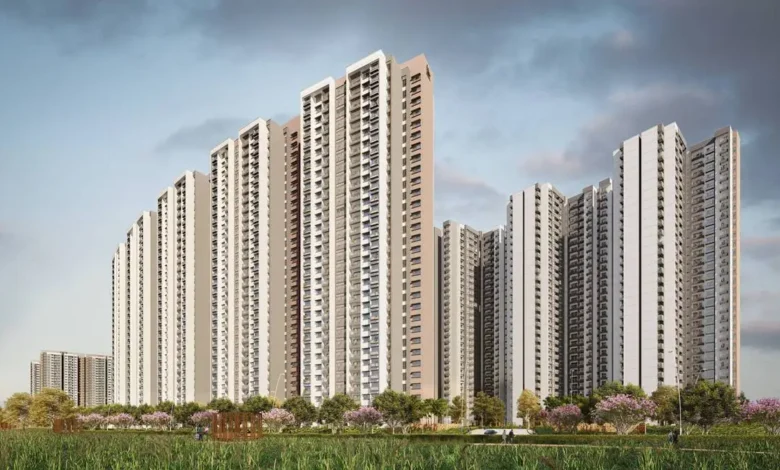
Quite often said in the world of luxury real estate, location is everything. The truth is that a factor other than location alone gives value to the price of a piece of property. In fact, day after day and as different markets related to real estate advance across the world, questions on real values in luxury properties remain most relevant than ever.
Recently, a management consultant by the name of Gurjot Ahluwalia sparked quite a lot of debate through a post on social media comparing properties worth $3 million in India and the United States. He has thrown light on some issues concerning cost, infrastructure, and quality of life that go with luxury real estate in India, especially what one can get in the U.S. for the same amount.
The comparison by Ahluwalia throws a very strong light on the Indian real estate market, which has often been blamed for the inflation of prices more than the value given to consumers. However, real Estate in America often offers better service regarding infrastructure and lifestyle as well as a better quality of life.
A Peek Inside $3 Million Properties in India and the United States.
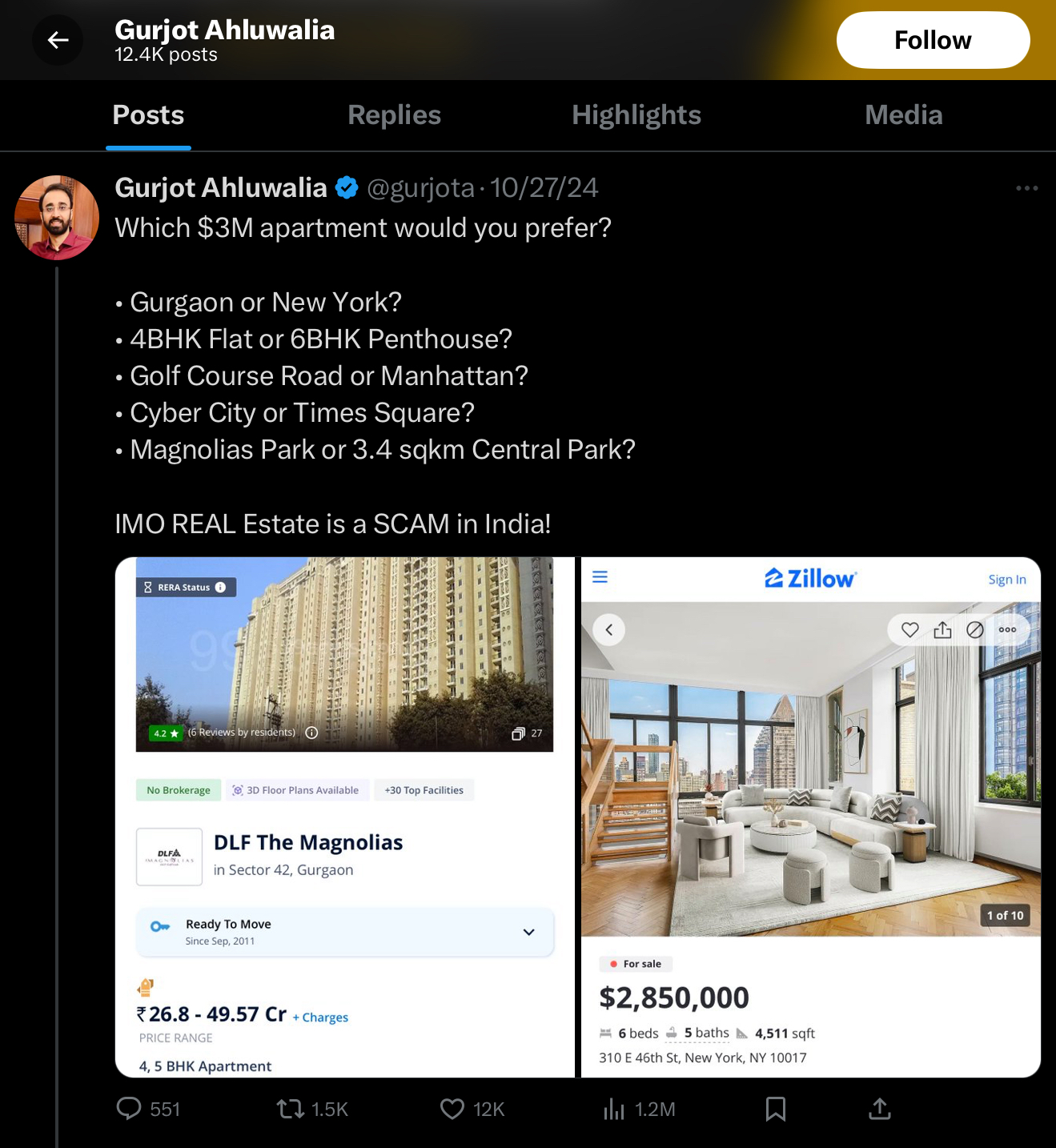
Before we move on to the more general issues, let us first consider the attributes that brought about this debate.
1. DLF The Magnolias, Gurgaon, India
DLF The Magnolias is among the country’s most prime residential complexes. Many of the wealthiest and most influential Indians live in this complex, which is located in Sector 42, Gurgaon. It has apartments up for sale at a price tag of about ₹25 crores, or $3 million, and the apartment spans some 5,000 square feet. This complex is well equipped with luxury features, including a swimming pool, gym, spa, landscaped gardens, and 24/7 security.
It is quite big and decently furnished. DLF The Magnolias is situated in Gurgaon city, which faces some serious infrastructural issues. Though it is a great commercial center, the place has massive traffic congestion, pollution problems, and unpredictable public utilities, all of which are undesirable characteristics for an external agent willing to pay high prices.
2. New York Penthouse
On the other side of the world, in New York City, that same $3 million could buy a penthouse overlooking the Manhattan skyline as far as the eye will see. There is this 4,511 square foot penthouse that carries all these high-end accompaniments: six rooms, five bathrooms, two rooftop terraces, plus a private guest house to top it off, not to mention central air conditioning and hardwood flooring.
But this property, unlike most, is more the city and infrastructure-lifestyle one finds in New York. It’s simply one of the world’s most advanced cities, boasting rich public transport, great medical facilities, an assortment of cultural generally considered very well worth paying for.
Comparative Comparison of Properties
| Parameter | DLF The Magnolias, Gurgaon | NYC Penthouse |
| Price | ₹25 crore (~$3 million) | $2.85 million |
| Size | 5,000 sq ft | 4,511 sq ft |
| Bedrooms / Bathrooms | Usually 4-5 BHK | 6 rooms / 5 bathrooms |
| Facilities | Pool, gym, spa | Rooftop terrace, guest house |
| Benefits at location | Closeness to business areas | Central Urban locality |
| Over All Value Per Sq. Ft | Approx. ₹50,000 ($600) | Approx. $ 630 |
From this comparative table, the U.S. penthouse is way more flexible and provides better additional features at about the same price. The thing that differs is the environment created around each of the property and the lifestyle each city is able to give. While the DLF The Magnolias in Gurgaon may provide enough space within the complex and good services, the external infrastructure plus the public facilities in Gurgaon do not even almost match New York City.
Understanding the Cost-to-Value Ratio in Real Estate.
When one is investing in real Estate, the cost-to-value ratio becomes a critical factor. Buyers look not only at the immediate property features but also at the broader environment that comes with it—city infrastructure, quality of public services, and the long-term potential for property appreciation. Real Estate in India and the United States varies widely in this regard, and here’s why.
India and the United States: How Real Estate Pricing Models Differ.
In India, luxury real estate is commonly sold as an “island” product. Developers market properties as exclusive enclaves with private amenities like gyms, pools, and security that are necessary because of deficiencies in public infrastructure.
Therefore, the $3 million apartment in India is too expensive because it needs to recover external deficiencies like needing better public transport, utilities which are unreliable, and there needing to be green spaces. The buyer pays for these gated amenities as if paying twice: first for the property itself, then again for the features that make up for the infrastructure that is lacking.
On the other hand, U.S. real estate in metropolitan cities like New York has vast urban planning, consistent public services, and high standards for amenities available to all people. Here, buyers are not primarily reliant on gated developments as a way of living a quality life; they utilize clean parks, expanded public transport, high-ranked healthcare, and stable utilities that improve living beyond the real Estate. As a result, this product’s price is directly in alignment with established infrastructure within the city that makes it easy for consumers to recognize and understand their actual value.
Maintenance Costs and Extra Expense.
Properties include maintenance as well as extra expense for both of these properties. There have been times when further diversions in real estate practices, as well as in urban standards, come through
In Gurgaon DLf the Magnolias.
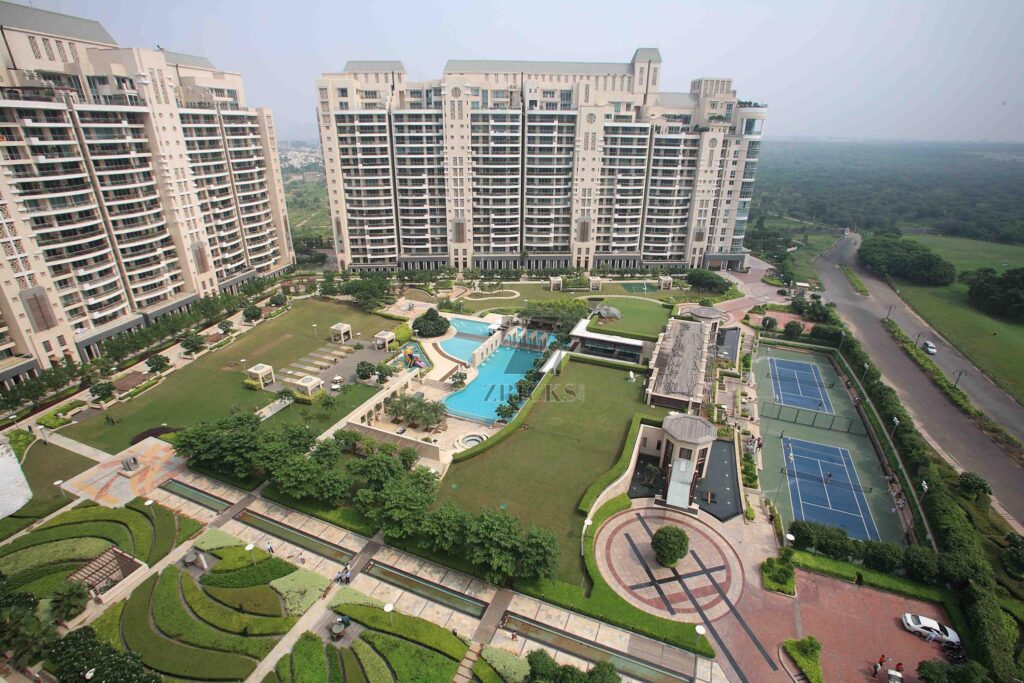
Maintenance charges in Indian luxury developments are usually reflective of 24/7 water and electricity backup, private waste management, and dedicated security. Buyers in the United States pay HOA (Homeowners Association) fees too, but in India, these costs are exaggerated since these luxury complexes must finance basic services that the city governments cannot provide reliably.
In reality, maintenance charges can also run into a few lakhs of rupees, making it another heavy-duty expense for the owner, although the rates are generally quite high and the electricity may still not be functioning at times or the taps dry up occasionally, thanks to the external infrastructure on streets, which are not handled by the developer.
Outside New York City
These prices can also get as exorbitant as tens of thousands of dollars in cities outside New York. But these costs are to pay for safe city utilities, including road upkeep, sanitation, and public transportation. In essence, these fees are more about the high standards of urban living for everyone than about exclusivity. And so, even with sky-high cost of living, most New Yorkers feel that they are getting strong value from the wide range of urban services and infrastructure that make life convenient and efficient on a daily basis. Return on Investment (ROI)
For the investors, it is an issue of return on investment
The Indian real estate market has acquired the tag of high price and uncertain return. The prime markets for this are Gurgaon and Mumbai. It witnessed the fastest rate of escalation of prices coupled with speculation and, as a result, it had become high-cost without a proportionate return. In fact, property prices in Indian cities, especially in those cities under study, have remained at a standstill or depreciated in the last couple of years due to some economic fluctuations, oversupply of luxury properties, and changing buyer preference.
It is impossible for someone to recover the sale price of an apartment for $3 million in the near future with DLF The Magnolias simply because property appreciation has declined and market demand is at its lowest level. Conversely, U.S. properties tend to appreciate consistently, mainly in prime areas such as New York City, due to strong demand, available space, and good urban planning that makes those areas more appealing. Investments in NYC, though prone to market instability, remain a good investment in the long run because properties there have historically gained more.
Quality of Life and Infrastructure: The All Important Differences
Another aspect of comparison here is the quality of life the citizens experienced in each city. Where one views living conditions and infrastructure provided to its people by Gurgaon and New York City, there couldn’t be more difference between the two.
Transport and Accessibility
New York City: New York is one of the most advanced public transportation systems in the world, including subways, buses, and commuter rails, so residents don’t have to use personal vehicles for city navigation. For a $3 million NYC penthouse owner, this means being able to access safe, quick, and efficient transport systems, which is one of the reasons the city appeals and leads to higher standards of living.
Gurgaon: The public transport system in Gurgaon is minimal, and most people rely on private cars or cab services. The traffic is one of the major problems along with bad road planning and long hours spent commuting that increase pollution. For the people living in DLF The Magnolias, luxury transport could be provided, but these cannot compensate for the unorganized public transport system, which lowers the quality of life by increasing congestion and pollution.
Public Services and Safety
New York City: Its services in health care, education, and emergency operations are complete and local tax funded. Public parks, libraries, hospitals, and emergencies are readily available, improving the quality of life on the whole. Safety conditions are generally good because of a responsive police and proper working emergency systems. For a $3 million property buyer, these services mean peace of mind and a well-rounded living experience that goes well beyond the apartment walls.
Gurgaon: Often, the quality of public services is variable in the area. At DLF The Magnolias, one gets high-class security and personal conveniences like club houses. In such cases, however, the same public hospital may not exist, nor can it meet the standard to support quality schooling. One finds lack of policing at one hand and a force too hard to access in many others. All this and delays from the emergency service also scare residents away from these neighborhoods. After all, as fine as the private convenience the Magnolias are, it only contributes towards overall comfort living experience if public amenities were half as reliable.
Pollution and Green Spaces
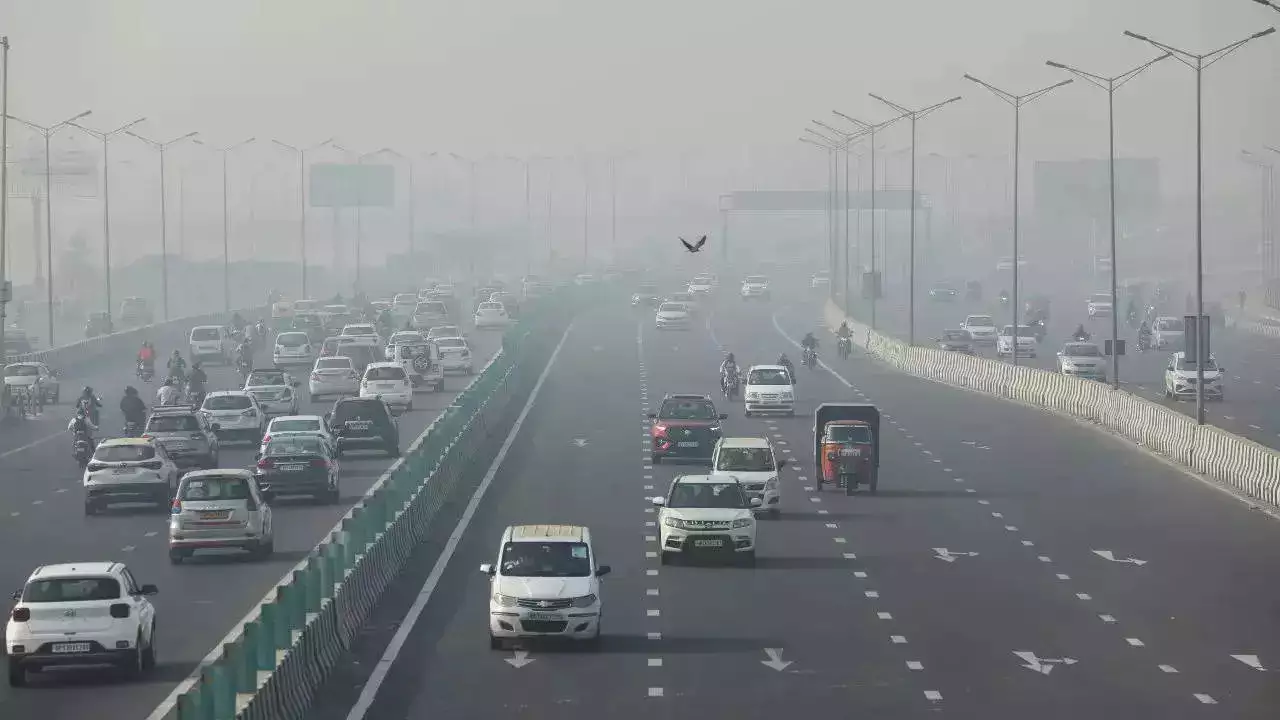
New York City: Despite its being a big city, NYC still has large areas of green spaces, such as Central Park, where its residents get enough clean, recreational areas. The pollution factor in the U.S. is also quite low, mostly because of strict environmental regulations. The high property tax is often justified by well-maintained public parks, clean air, and standards for water quality.
Gurgaon: The phenomenal, uncontrolled urbanisation in Gurgaon resulted in high pollution levels along with very little green coverage. Though the private garden and controlled indoor environment of DLF The Magnolias have their advantages, stepping outdoors often results in high pollution levels and fewer well-managed parks. This environmental factor of luxury living reduces the urge to live in such places due to a lack of access to clean outdoor spaces as well as recreational areas.
Case Study: Real Estate for an Indian Expat in India and the United States
To put more human touch on the above disparity in the Indian versus U.S. real estate markets, let’s explore the case of Rajesh Sharma, an Indian expatriate from Gurgaon, moving to New York City due to his work. Here is what this difference feels like in reality.
Background and Expectations
For many years, Rajesh, an executive in a multinational company, had been residing in Gurgaon. Luxury apartment housing in DLF The Magnolias was his home – with all the paraphernalia of elitism but also with the irritations of growing traffic congestion, pollution, and inadequacy of public services. The offer of his company to transfer him to New York City came at just the right time for him to experience a new benchmark of urban life.
Value and Lifestyle Comparison
After settling in New York, Rajesh rented an apartment similar to the $3 million penthouse in the question. The maintenance and taxes were high, but he was impressed by how comprehensive the public services in New York City were-transport efficient and community activity.After settling in New York, Rajesh rented an apartment similar to the $3 million penthouse in the question.
The maintenance and taxes were high, but he was impressed by how comprehensive the public services in New York City were-transport efficient and community activity. He was paying more in taxes and upkeep than he was in Gurgaon, but he felt that he was getting a far more complete living experience in return. He had never experienced this sense of value while living in his Gurgaon apartment, no matter how many luxurious features it boasted of.
Summary from His Experience
This was perhaps most evident in the experience of Rajesh, where he found that “luxury” felt empty and vacuous when it was contained within one apartment or gated community, severed from the broader urban fabric. While he loved his life in New York, in Gurgaon, every day he gazed at his posh apartment and, by extension, at his well-crafted lifestyle; around it lies the underdevelopment.
Indian Real Estate compared with Global cities
London, UK
London is one of the world’s priciest markets, but infrastructures, safety, and quality of life are what contribute to the reasonability of prices. For example, sites like Kensington or Chelsea lying in the central areas can be compared to the same level that one achieves upon visiting these high-end sites like New York or Tokyo. This £3m budget in London could help a family with a tiny flat in one of London’s top postcodes but is reinforced with great free public services that include outstanding healthcare services-NHS-that is free; public transportation-the Underground; and more.
Amenities and Services: The high property taxes and council taxes in London are used to fund public amenities that everyone in the area has access to. From good schools and hospitals to Hyde Park, all these come with being a resident of London. This means even the low-income earners can have a quality life while the high-end buyers see this as adding value to their investment.
Market Stability: The London real estate market is sensitive to changes, especially political ones like Brexit. However, the market is known to be stable over long periods and appreciative in value. The buyer can be sure that high prices are balanced by lasting value in a historically prestigious market that attracts global appeal.
However, Indian luxury developments, such as DLF The Magnolias, require charging a premium for services and amenities that fill gaps in local infrastructure, which tend to go unattended. However, market speculation, urban planning constraints, and political or economic instability result in a less consistent appreciation pattern for properties; therefore, in the Indian market, lesser predictable.
Sydney, Australia
The real estate prices are booming in Sydney due to its being a safe city and culturally vibrant. And just like New York, a $3 million could get a high-end flat with a view of that iconic Sydney Opera House landmark. The appeal of this city is further heightened in terms of sustainability, public spaces, and urban planning in the city.
Environmental considerations:
Clean, accessible public spaces in Australian cities enhance the quality of life, which in turn increases demand and value for nearby real Estate. For luxury buyers, proximity to clean beaches, green spaces, and low-emission zones adds value without the need to pay a premium for exclusive “gated” access, as seen in many Indian developments.
This inclusion of quality public spaces into the urban life means Australian real Estate holds its value through time, in contrast to India’s pollution and infrastructural problems, such as those in Gurgaon, where pollution is an issue that lingers because of fast-paced urbanization, poor waste management, and vehicle emissions.
While luxury properties in India may promise green spaces and cleaner air within gated communities, they are isolated solutions that cannot help ward off the bigger picture of environmental issues facing the city. Hence, Indian buyers may think that they are paying more for the luxury property, which could only partially shield them from environmental concerns. Comparison of India’s Luxury Market with Environmentally Conscious Markets
Resilience, public health, and general quality of life for environmental sustainability emphasize how value is created in Australia’s real estate markets. The premium paid in a city like Sydney is related to knowing that the investment placed there aligns with living standards founded on sustainable parameters and retains value in a globally conscious economy that values environmentalism.
For now, as a matter of market standardization, sustainability practices have yet to gain acceptance across luxury real estate in India. Ecoharmoneous development may exist but exceptions more than the rule. So Indian buyers can make it feel that luxuries sold in these segments have the quality of life and long-term security which, perhaps they are deprived of in markets environmentally concerned.
Global Lessons for Indian Real Estate
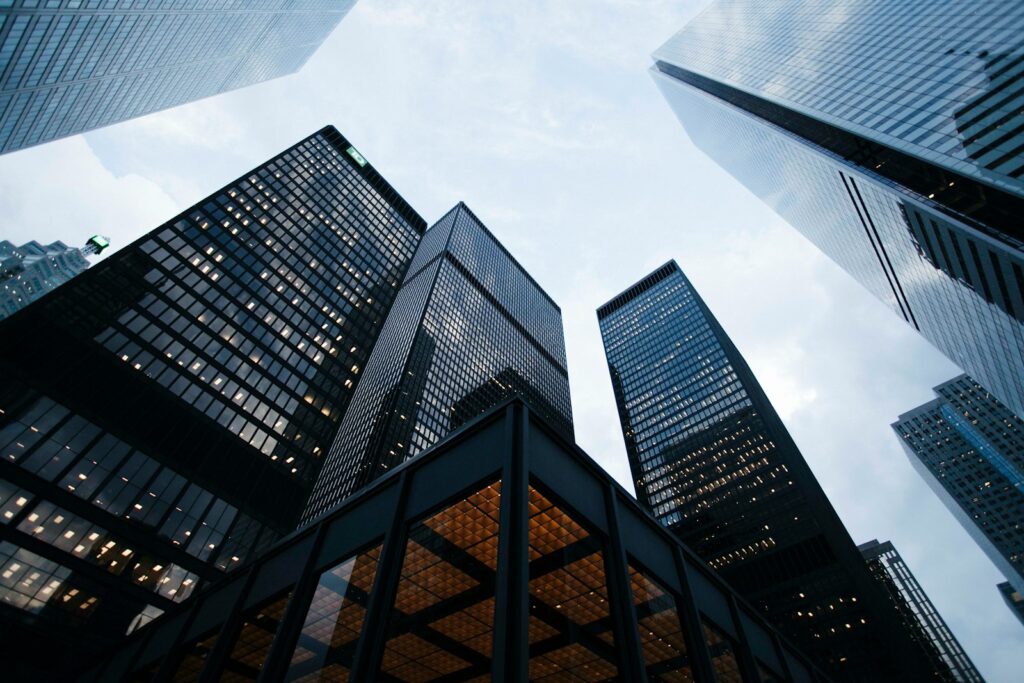
As the cities in India continue to attract more people, the pressure on luxury real estate rises to incorporate global best practices in sustainability, infrastructure, and urban integration. While learning from cities like New York, London, Sydney, and Singapore, it’s clear that high real estate prices are easier to justify if they are linked with actual value through services, environmental sustainability, and quality of life improvements.
For India’s market to change from the “scam” perception, the following differences would make the place better
Investment in reasonable public transport, waste management, and control of pollution would fill the gaps of private developers, making luxury living sustainable rather than isolated.
Enforcement and acceptance of green building codes make Indian cities more livable. Luxury realty aligns with global, eco-friendly standards, which will thereby increase the overall property value in the long term. The markets will then stabilize and show more confidence and less turbulence through tightening policy provisions for price controls so as to curb speculative sentiments and strengthen protection to buyers.
That is to say, if more luxury properties are integrated into the urban space instead of being isolated in gated communities, residents may be living a more vibrant lifestyle without the appeal of artificially inflating self-contained developments.
Final Thoughts
This leads the bottom line to make a clear case for change in terms of value delivery from Indian luxury properties. Perhaps this is where high-end Indian developments fall short: phenomenal amenities but operating in an environment with less-than-consistent urban infrastructure, sustainability, and environmental quality. This results in overpriced products that lack the integrated benefits of more environmentally and socially developed real estate markets.
If the Indian real estate market could take a cue or two from cities like Barcelona with strong environmental standards and effective public infrastructure combined with reliable market stability, this alone would transform the image of the market. This buyer will be able to claim credibility that their money actually adds up to a quality environment, not just insulation from the ambient metropolitan mess.
Indian real Estate could emerge as a market criticized for its price and low value and emerge into a true market reflecting and respecting the needs of its residents. The holistic approach for this, focusing on sustainability and connectivity along with good public infrastructure, will change the Indian luxury real estate scenario to become an actual investment and not a perceived “scam.”




